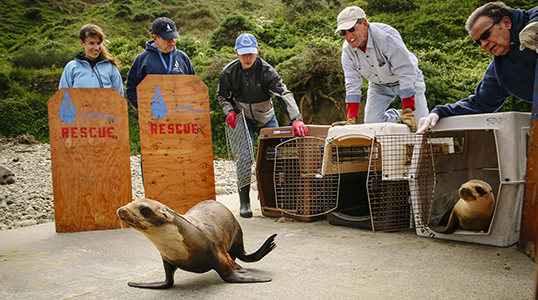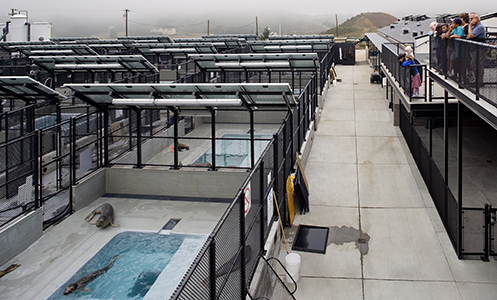The Marine Mammal Center has come a long way in the last 40 years. When founders Lloyd Smalley, Paul Maxwell and Pat Arrigoni set out to help sick and suffering marine mammals that were stranding on the California coast, they were equipped with little more than kiddie pools, garden hoses and ambitious dreams.

Volunteers from the Marine Mammal Center release California sea lions at Chimney Rock in Point Reyes National Seashore. Photo Conner Jay © The Marine Mammal Center
By Sarah Van Schagen
Published: September, 2015
The Marine Mammal Center has come a long way in the last 40 years. When founders Lloyd Smalley, Paul Maxwell and Pat Arrigoni set out to help sick and suffering marine mammals that were stranding on the California coast, they were equipped with little more than kiddie pools, garden hoses and ambitious dreams.
In 1975, they established the Marine Mammal Center on the site of a former Nike missile silo in the Marin Headlands, just north of the Golden Gate Bridge. A sea lion named Herman was the first patient to be treated and released.
Since then, the center has responded to over 20,000 marine mammals and grown into a world-renowned hospital, research center and education facility. More than 1,100 volunteers support 50 staff in all areas of operations, from animal care to education.
A nonprofit supported largely through donations, the Marine Mammal Center is the only organization authorized by NOAA Fisheries to rescue and provide veterinary care to sick and injured marine mammals along 600 miles of coastline from San Luis Obispo to Mendocino.
The center’s state-of-the-art hospital facility (still located atop the former missile site) can house more than 200 seal and sea lion patients at a time. Animals are rescued for a variety of reasons, including malnourishment, maternal separation, entanglement in ocean trash and disease. After being successfully treated, healthy animals are released back to the wild.
During a typical year, the center admits 600 to 800 patients, but the number of distressed animals has increased in recent years. This year, The Marine Mammal Center commemorates its 40th anniversary during one of the worst years on record for California sea lions, the hospital’s most common patients.
The influx of stranded sea lions this year has been caused primarily by unusually warm waters off the coast of California that have affected food availability for sea lion mothers nursing their pups on the Channel Islands. Abandoned and starving, many of these pups left the safety of the shore and headed off to sea before they were old enough to fend for themselves.
These are pups like Percevero, who was rescued earlier this year when he crossed a four-lane road near Fort Funston in the Golden Gate National Recreation Area. The center’s veterinary experts determined that he was suffering from malnutrition, pneumonia and parasites, in addition to being too young to survive without his mother.
Like the hundreds of other sea lion pups the Center was caring for, Percevero was fed a nutritional fish smoothie multiple times a day until he was old enough to learn how to catch fish on his own.
“Over the last 40 years, the Marine Mammal Center has evolved into the largest rehabilitation hospital of its kind in the world,” said Executive Director Dr. Jeff Boehm. “This has allowed us to provide not only an effective response to the current sea lion crisis, but also a focus on scientific research to help prevent similar crises in the future.”
One sick sea lion won’t tell you much about the health of the greater population. But thousands of sick sea lions rescued over the course of four decades have taught scientists at the center a great deal. They’ve discovered entirely new illnesses with relevance to human health issues and gained a greater understanding about the health of the ocean as a whole.
California sea lions like Percevero serve as sentinels of the sea, alerting researchers to the dangers they face. Rescuing these animals can help raise the alarm and inspire public action on threats like pollutants, ocean trash, overfishing and global warming.
“Many of the threats marine mammals face are human impacts,” said Dr. Shawn Johnson, director of veterinary science at the Center. “So we feel an even greater responsibility to rescue, rehabilitate and return these animals to the wild.”
Percevero is one of the lucky ones. After six weeks of care, he had nearly doubled in size and was given a clean bill of health—living up to his Latin name, which means “to persevere.” He was released back to the wild at Chimney Rock in Point Reyes National Seashore along with six other young sea lions.
Thanks to the success of the Marine Mammal Protection Act, many of the species the Marine Mammal Center rescues along the California coast, including sea lions, are no longer endangered. But everything the Center’s veterinary team has learned about marine mammals in the last four decades has helped them become experts in how to care for species that are still at risk of extinction.
In 2014, the Center opened a brand-new hospital on the Big Island of Hawaii to care for the critically endangered Hawaiian monk seal. Named Ke Kai Ola, Hawaiian for “the healing sea,” this facility has already helped rehabilitate and release six healthy Hawaiian monk seals to the wild. Two patients currently in the hospital’s care will return to the ocean soon. With fewer than 1,100 Hawaiian monk seals alive today, every healthy animal is crucial to the species’ survival.
That’s why the Marine Mammal Center is committed to going beyond rescue and research to provide educational programming that ultimately inspires action and fosters stewardship of our ocean environment. From school programs to summer camp to daily docent-led tours, there are opportunities for all ages and interests.
The center is also open daily to the public from 10 a.m. to 5 p.m., allowing visitors to see much of the day-to-day work of staff and volunteers as well as explore exhibits about marine mammal health and see current patients from one of two observation areas. The center’s retail store offers gifts ranging from apparel to books to toys and activities for kids—and all proceeds go toward patient care.
You can also help support the Marine Mammal Center’s work by visiting its website at www.marinemammalcenter.org to learn more about volunteer opportunities and ways to donate.

Visitors watch marine mammal patients rehabilitate at the Marine Mammal Center. Photo David Wakely © The Marine Mammal Center

California sea lions are the most common patients at the Marine Mammal Center. Photo Ingrid Overgard © The Marine Mammal Center

